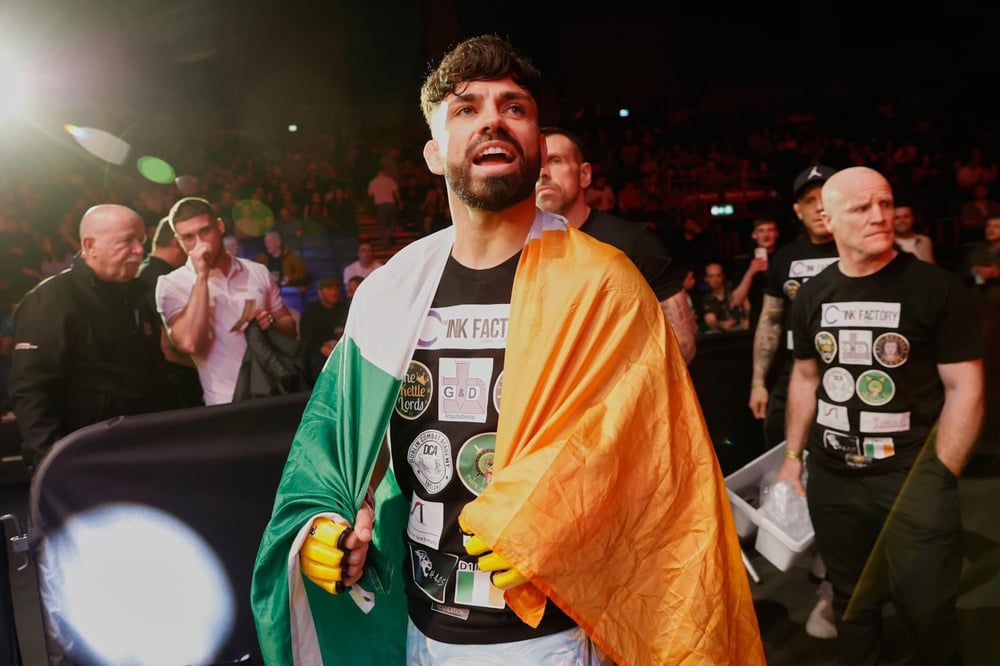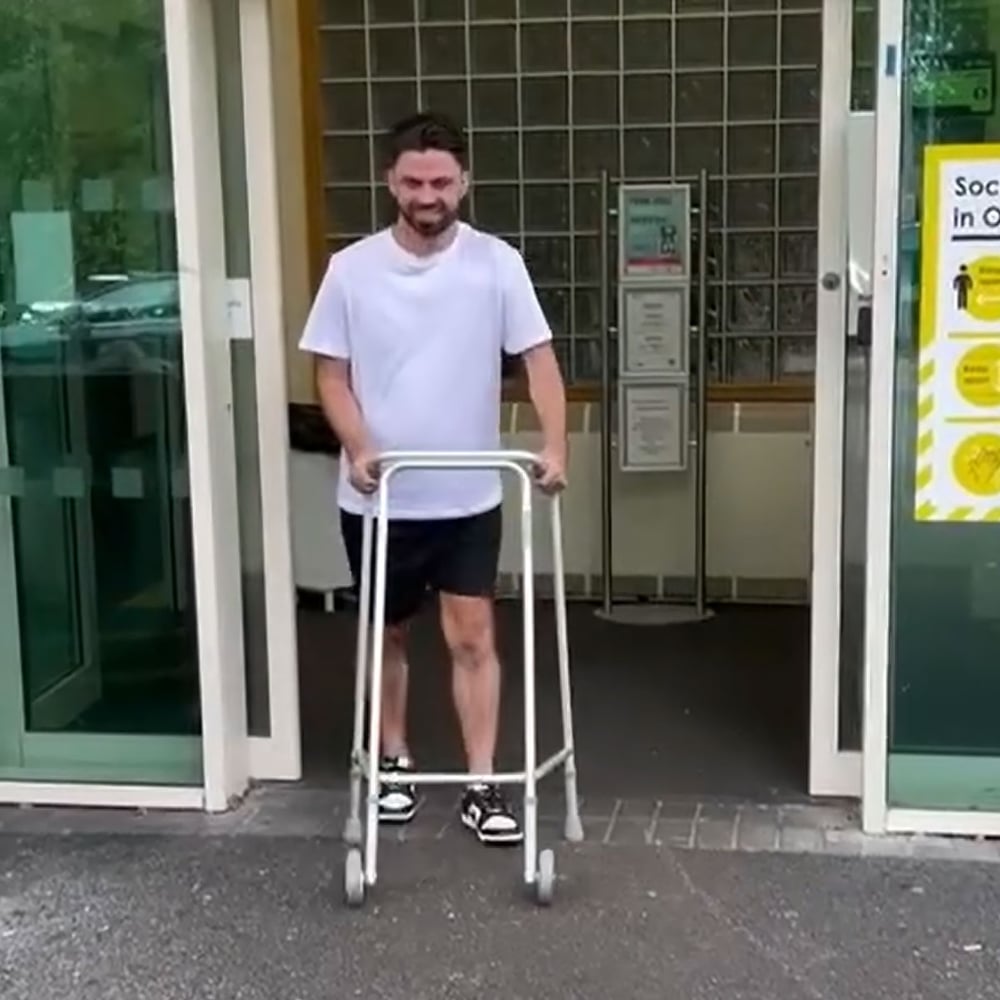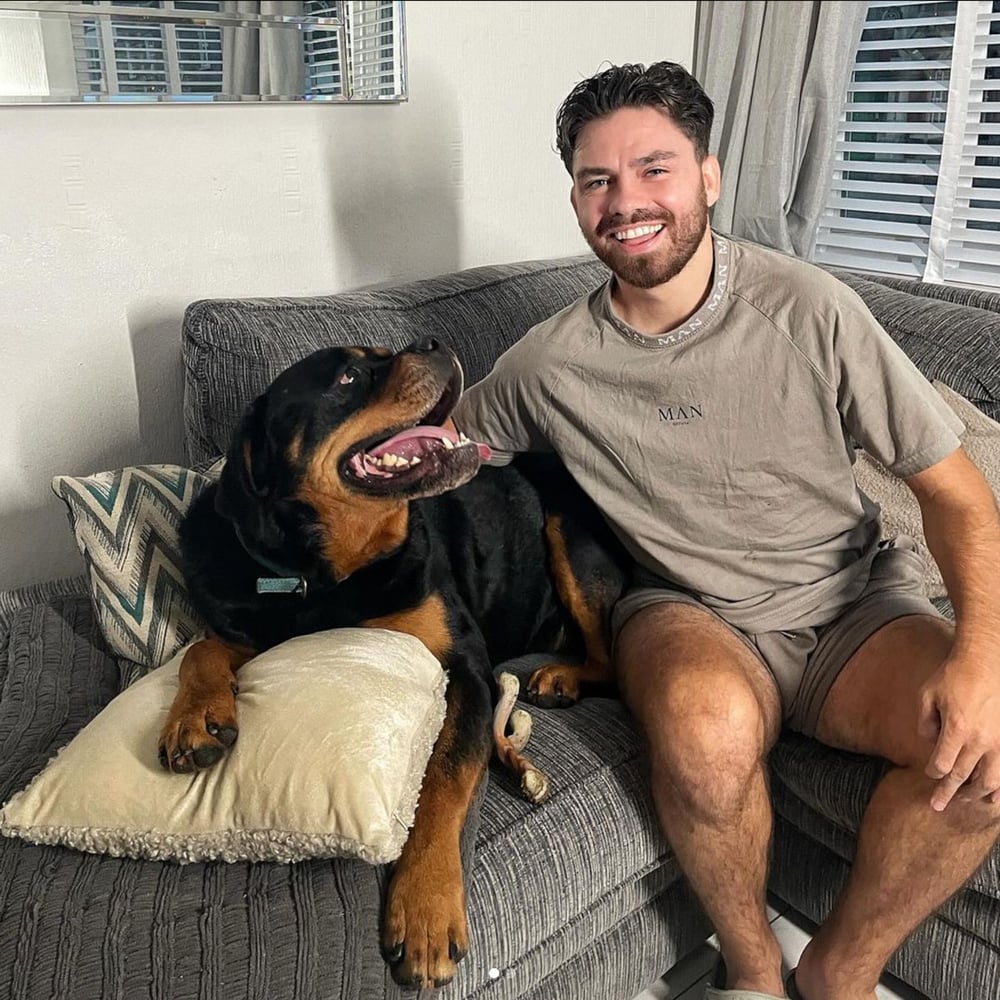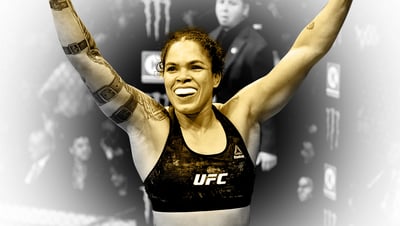
Issue 210
October 2024
The tragic story of Ryan Curtis’s back-breaking injury caught the attention of the MMA world earlier this year, and Fighters Only’s Paul Browne caught up with him to speak about his incredible progress.
The world of combat sports is built on a bedrock of dreams, gambling it all to create a legacy they can be proud of forever. But far beyond the lights, the glamour, and the glory, we find the violent truths of the fight game. We often forget the pain of the broken bones, the reality of the blood on the canvas, and the severity of the risks these fighters take.

For Ryan Curtis, the dream turned sour at the beginning of this year. The 30-year-old Irish flyweight suffered a horrifying accident in the training room, which resulted in him being paralyzed from the neck down and being told by doctors that he would most likely never walk again.
“This particular Thursday was just like every other one,” Curtis explained. “Always tough wrestling, lots of fighters on the mat putting the work in. We all had fights coming up, so we were all pushing ourselves hard. I remember we were doing positional rounds, starting on all fours. The aim was to either get back to your feet or at least recover guard. I was getting back up, but my arm got trapped on one side. It was almost a perfect storm of bad stuff that can happen in those situations. Remember when Kevin Randleman picked up Fedor and slammed him on his head? The guy picked me up and dumped me on the side where my arm was trapped, so I obviously wasn’t able to post with it. I remember being very high up in the air because I gave him the momentum to lift me as I was getting back up to my feet, and I remember looking down at the mat as if I was moving in slow motion and thinking, ‘this is not gonna be good.’ I hit the mat on the side of my neck, and I remember trying to scream, but I wasn’t able to because the injury happened so high up in my spine it affected my breathing. I remember struggling to even breathe. I was lying face down, and everybody started to gather around me. I pressed my face into the mat to try to move because the pain was absolutely unbearable. I’ve never felt anything like it. It was so bad. In hindsight, it was such a stupid thing to do, but at the moment, I wasn’t thinking clearly. The pain was so intense.” Athletes involved in high-risk sports simply cannot afford to contemplate the possibility of this type of tragedy.

NOT THINKING ABOUT
The need to compartmentalize any fear is a must for every fighter. A split second of hesitation is the difference between victory and defeat. A career inside the cage is inherently unstable, so Curtis immediately thought about his three-year-old daughter Kassia.
“I’m okay speaking about it now, but what really used to make me upset is the memory of lying on the mat, and the first thought that came into my head was, ‘You’re never going to hold your daughter again.’ I didn’t know the extent of the injury, but I remember thinking I was never going to be able to hold her again. The ambulance took something like two-and-a-half hours to come, and I remember that initially when I arrived at the hospital, I was able to move my arms and my legs. But the whole time, I was lying there with a broken neck, and it was pinching my spinal cord, and that was the real problem. I broke my C4 and C5, and whatever way it broke made it impinge on my spinal cord. The C4 practically exploded into nothing. If this had happened to multiple vertebrae, I would have been better off because it wouldn’t have pinched my spinal cord the way it did. The doctor told me he had never seen a broken neck this bad. If I had just broken my neck or my back, that would have been bad enough, but it’s the spinal cord injury that actually paralyzes you. I remember going for a scan, and that’s when I saw the mood change with the doctors. They said they needed to get me into surgery immediately. I woke up the next morning, and I was paralyzed from the neck down. It's crazy to be in a situation where you’re lying there looking at your feet and can’t move or feel them. You move all your life, and all of a sudden, you can’t. You’re trying to send signals to your body to move and nothing’s happening. That feeling is something that I’ll never forget. I was in the intensive care unit (ICU) for the first ten days, and that was probably the worst part. Dealing with horrendous nerve pain and battling with the onset of delirium. I was hallucinating that I was falling off the edge of a building or being dragged around on the ceiling.”
THE TURNING POINT
Ryan ‘Chaos’ Curtis first fought professionally in 2011 and has competed in organizations such as Bellator, Cage Warriors, and Brave Combat Federation throughout his storied career. He has grown accustomed to proving people wrong, and he insisted from day one that this challenge was one he possessed the tools to overcome.
“Even while I was in the ICU, I remember telling people that I was going to recover,” he explained. “I think people were listening to me and thinking, ‘Yeah, OK, Ryan.’ Nobody started to believe in me until I came out of there and moved into the hospital ward and slowly began to move things, started to wiggle my toes and that kind of thing. I always believed it. I really did. Looking back, it’s crazy how confident I was. I remember looking at the doctors and thinking, ‘You guys just have no clue who you’re dealing with here.’ They were convinced I was some kind of fool and had no idea how bad the situation was, but I was looking at them in the exact same way because I was so confident, and I kept thinking that they were the fools for even suggesting that I was never going to be able to walk again! I just kept thinking, ‘Of course, I’ll walk again. I’m going to do whatever I want from here.’ It’s not that moving out of ICU was a turning point for me because I feel like I always had that belief that I’d recover. But that was the point when other people around me started to realize that it was possible.”
DOCTOR’S ORDERS
Although Curtis knew he could defy the odds, the doctors disagreed.
“They told me, ‘This doesn’t look good, you’re never going to walk again. You’ll be lucky if you can sit up in your bed. Best case scenario, you’ll be in a wheelchair for the rest of your life.’ It was easy for me to dismiss them. I made sure from the beginning that I used phrases like ‘When I walk again,’ not ‘If I walk again.’ It was never in question. I spent a lot of time focusing on positive visualization. This is something I’ve always done. For years, I’ve been listening to guys like Joe Dispenza, Brian Tracy, Bob Proctor and Tony Robinson. It was Conor McGregor that introduced me to all of that stuff. I remember he told me about this book called Money and the Law of Attraction. I used to play it in my Nissan Micra when I was an amateur fighter. It was all about visualization and self-belief. Conor loved all that stuff. I remember we all thought he was mad. Then he became the Cage Warriors champion, and that changed my tune. I started reading up on the topic. So, I was way ahead of the game when it came time to start on the road to recovery. That’s why I was so headstrong and confident."
When he first arrived at the rehabilitation center, Curtis could barely move his fingers. Three months later, he shocked everybody by walking out of there, albeit with the assistance of a Zimmer frame.

“I could tell you that it felt amazing to do that, but the reality is I had said from day one I was going to do it, so it just felt normal to me when it happened. It was no shock to me. I remember telling people over and over that I planned on walking out of that unit. I think the only people that truly believed in me were the people from the gym, my teammates, and my coaches. I remember Pat McAllister (one of Curtis’s coaches) telling people over and over, ‘You have no idea what this guy can do. They’re going to study this comeback.’ He was one of the first ones to back me up, but I always believed. It was the people who knew me from within the fight game that believed in me the most because they knew me and understood what I’m capable of.”
CONTINUING THE ROAD TO RECOVERY
News of the Dubliner’s accident spread across social media, and a gargantuan fundraising drive began. Friends and teammates rattled buckets and organized events to enable him to make plans to take his rehabilitation to the next level.
“After getting out of hospital, I stayed one night at home and left for Colombia the next day,” he says. “Bear in mind that although I walked out of the hospital, I was still extremely limited in my movements at this point, so the twenty-three-hour journey to Medellin was rough. It was heavy. But I didn’t want to get too comfortable at home. I just wanted to attack the next phase of my recovery head-on. It was such a breath of fresh air when I got to the BioXcellerator clinic in Colombia. It was the first real-time throughout all of this that I was surrounded by people who had a positive outlook. They had been so negative, and it was such a drag in the hospital system in Ireland, so the difference when I arrived in Medellin was refreshing. I was there for a week. It was very intense. I was receiving some sort of recovery treatment every day, going to hyperbaric chambers, receiving stem cell injections both into my spine, and through an IV, I had some O-zone therapy. It was a fantastic experience.”

THE NEXT PHASE
Curtis traveled from Colombia to Dallas, Texas, where he spent two months working diligently on his rehabilitation at REACT, a neuroscience-driven strength and conditioning center with a history of helping people recover from spinal cord injuries.
“That’s when I fully realized the seriousness of my situation,” he admits. “I was the only one there with this type of severe injury. There was a woman I worked with there, and she told me that only twice in sixteen years had she seen somebody with a spinal cord injury this bad, and the other guy wasn’t able to do half the things that I could at that point – get up, walk around and so on. Considering she had dealt with hundreds of people there, that took me by surprise. Once I saw everybody else there, I finally understood. That was a big turning point. I realized how lucky I’ve been. I’ve worked so hard to get to where I am now, but I really have to credit everybody else who has helped me. If the surgeons hadn’t fixed my neck, I probably wouldn’t be alive right now. I stayed there for a month, at which point I really wanted to come home. I didn’t want to be over there on my own, but I knew it was the right thing to do, so I extended my stay by another month. That was probably one of the lowest points in my life. I remember feeling so upset every day because I was missing my little girl back home. I was feeling so low in myself. It was so tough not being around my own people and, most importantly, missing so much of Kassia’s life. When kids are that young, they’re like puppies. When you don’t see them for a couple of weeks, you’re almost shocked by how much they’ve grown. Texas was heavy on the heart for me. But in another way, it didn’t matter. I’m able to go into ‘robot mode.’ It’s conditioned into me from my life in the fight game, I can be disciplined no matter what. I had some of the worst days of my life over there, horrendous days just lying in bed and not wanting to move. But never, ever one single day, not one hour, not one minute did I skip training. I didn’t miss a single moment of it. I didn’t care how bad I felt. I went to training depressed, I was in rehab depressed, I didn’t care. I was there. And I still gave 100% effort while I was doing it because I knew it was all for her. I showed up every single day, and that’s most of the battle. But it was so tough.”
HOME TRUTHS
Curtis arrived back in Ireland at the beginning of August and has been consistently working day in and day out on his rehabilitation at the Irish Strength Institute. Having achieved his first goal of getting back on his feet, hearing what he thinks the future holds for him is inspiring.
“I remember seeing Kassia for the last time before I left for Colombia,” he says. “We went to a playground. I left there feeling absolutely heartbroken that I couldn’t lift her up. That really hurt, but it lit an extra fire under me and gave me another gear I could tap into for motivation. I’m at a point now where I’m able to play with her and interact with her, but I’m still building back up slowly. I’m by no means where I want to be, but I’ve managed to lift her up and hold her. Like I said from the very beginning, if I can get to a point where I’m able to play with my daughter without any problems, I’ll be the happiest man in the world. That’s what’s most important to me. I initially thought that would be the absolute most I could hope for, but now that I’m here, I’m looking beyond that.”
THE POWER OF MMA COMMUNITY
Something must be said about how MMA brings people together, forming tribes that help each other until the job is done. Even though Curtis is no longer at training, he’s still in his gym’s heart.
“Even now, ten months on from the accident, people are still out there doing fundraisers for me,” he says. “I’ll never be able to repay everybody who has helped me, but the support has been phenomenal. It really has. It’s humbling to see how many people care about me. My whole life, I’ve always liked helping people, and I’ve never done it to get something in return. I help people because I truly believe good people help each other.
I needed all the help in the world, and I got it, and I’m still getting it. The fundraisers have enabled me to get rehab and travel to different places for treatment. I’m grateful, and I feel like it’s come full circle because I’ve always gone out of my way to help others when I’ve been in a position to. I feel like this will be my path in life going forward: helping other people in need. I feel obligated because I’ve received so much help, I want to pay it forward. Help people get through things. I’ll find a way to do this.”
The fight game can be a cruel mistress, where triumph and tragedy intertwine in the blink of an eye. Ryan’s journey is a testament to the value of building a strong, resilient mind and refusing to be defined by your circumstances. The grit forged in MMA doesn’t just create champions, it powers fighters to overcome life’s most challenging battles. It’s clear real victory often relies on the MMA community, where support becomes a lifeline, proving that fighters never truly battle alone.











